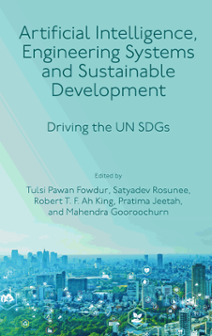
Index
Artificial Intelligence, Engineering Systems and Sustainable Development
ISBN: 978-1-83753-541-5, eISBN: 978-1-83753-540-8
Publication date: 18 January 2024
Citation
(2024), "Index", Fowdur, T.P., Rosunee, S., Ah King, R.T.F., Jeetah, P. and Gooroochurn, M. (Ed.) Artificial Intelligence, Engineering Systems and Sustainable Development, Emerald Publishing Limited, Leeds, pp. 271-282. https://doi.org/10.1108/978-1-83753-540-820241021
Publisher
:Emerald Publishing Limited
Copyright © 2024 Tulsi Pawan Fowdur, Satyadev Rosunee, Robert T. F. Ah King, Pratima Jeetah and Mahendra Gooroochurn. Published under exclusive licence by Emerald Publishing Limited
INDEX
- Prelims
- Chapter 1 Advances of Artificial Intelligence in Engineering
- Part 1 Impact of AI-Enabled Chemical and Environmental Engineering Systems on UN SDGs
- Chapter 2 Adoption of Machine Learning for Sustainable Solid Waste Management
- Chapter 3 Smart Fertilizer Application in Agricultural Land for Sustainable Crop Production and Consumption
- Chapter 4 Predicting Household Plastic Level Consumption Using Machine Learning and Artificial Intelligence (AI)
- Chapter 5 Ant Colony, Bee Colony and Elephant Herd Optimisations for Estimating Aqueous-Phase Adsorption Model Parameters
- Part 2 Impact of AI-Enabled Civil Engineering Systems on UN SDGs
- Chapter 6 Artificial Intelligence–Based Clean Water and Sanitation Monitoring
- Chapter 7 Achieving SDG Targets in the Land Transport Sector Using Intelligent Transportation Systems
- Part 3 Impact of AI-Enabled Electrical Electronic and Telecommunications Engineering Systems on UN SDGs
- Chapter 8 Achieving Affordable and Clean Energy Through AI and 5G Powered Internet of Energy (IoE)
- Chapter 9 Leveraging the Power of Blockchain in Industry 4.0 and Intelligent Real-Time Systems for Achieving the SDGs
- Chapter 10 A Reliability-Based Two Stage Phasor Measurement Unit (PMU) Placement Optimisation Model Using Mathematical- and Nature-Based Evolutionary Algorithms
- Chapter 11 Quantitative Assessment of Models and Indices for Interior Thermal Comfort Taking Into Account the Effects of Solar Radiation and Wind
- Chapter 12 The Role of the Internet of Things for a More Sustainable Future
- Part 4 Impact of AI-Enabled Mechanical and Mechatronics Engineering Systems on UN SDGs
- Chapter 13 Mechatronics Implementation of Passive Building Elements to Improve Thermal Comfort and Promote Energy Efficiency in Buildings
- Chapter 14 Demystifying Climate Change and Climate Action Through the Circular Homes Concept – An Educational Tool for Community Engagement
- Chapter 15 Robotics and Automated Systems for Enabling an Industry 4.0 Transformation in Mauritius
- Chapter 16 Potential Beneficial Impact of AI-Driven Atmospheric Corrosion Prediction on the UN Sustainable Development Goals (SDGs)
- Chapter 17 In Situ Durability Assessment of Natural Composite Structures by Considering Artificial Neural Network (ANN) Modelling
- Part 5 Impact of AI-Enabled Sustainability and Enterprise Development on UN SDGs
- Chapter 18 The Manufacturing Sector in Mauritius: Building Supply Chain Resilience and Business Value With Artificial Intelligence
- Chapter 19 AI for Social Good: Opportunities for Inclusive and Sustainable Development
- Chapter 20 The Applications of Artificial Intelligence in the Textile Industry
- Index